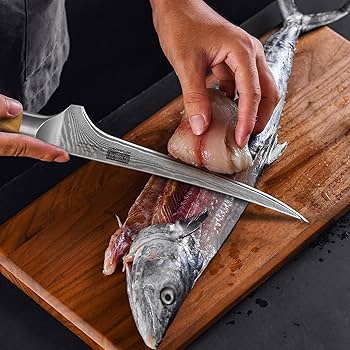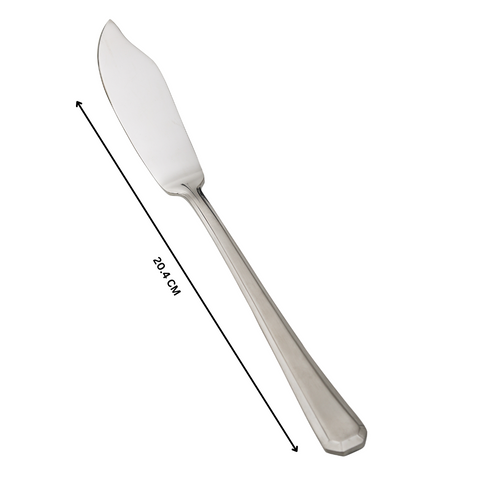Discover the Essential Functions to Seek in a Top-Quality Fish Knife
When choosing a fish knife, numerous key functions require interest. The blade product significantly influences sturdiness and sharpness, while versatility plays a critical role in accuracy. Furthermore, the handle style impacts convenience throughout prolonged usage. Edge retention and safety attributes are also crucial for useful use. Recognizing these components will certainly direct consumers towards making an informed choice, yet the nuances of their relevance may not be promptly clear.
Blade Material and Building And Construction
The efficiency of a fish knife largely pivots on its blade material and building - fish knife. Top quality fish blades typically include blades made from stainless steel, high-carbon steel, or a combination of both. Stainless-steel is favored for its rust resistance and reduced upkeep, making it perfect for freshwater and deep sea settings. High-carbon steel, while prone to rusting, provides remarkable intensity and edge retention, attracting those that focus on reducing performance
The building of the blade additionally plays a crucial function in its performance. Full-tang blades, which extend the entire length of the take care of, offer improved toughness and equilibrium. On the other hand, partial-tang blades may jeopardize resilience. In addition, the density of the blade should be thought about, as thinner blades allow for much more exact cuts, vital for fragile fish filleting. Eventually, a sound blade, using the appropriate products, is essential for accomplishing the ideal results when preparing fish.
Blade Flexibility and Length
Blade flexibility and size are critical factors that substantially affect the efficiency of a fish knife. A flexible blade enables exact cuts and the capability to maneuver around bones and skin, making it vital for filleting fish efficiently. The best amount of adaptability can improve control, enabling the customer to achieve clean, smooth cuts with very little effort.
In terms of length, fish blades typically vary from 6 to 9 inches. A longer blade is helpful for larger fish, offering the reach needed for reliable filleting. On the other hand, a much shorter blade provides maneuverability, making it ideal for smaller fish or complex tasks.
Inevitably, the selection of versatility and length ought to straighten with the certain fishing demands and preferences of the individual. A healthy combination of these qualities makes sure optimal performance, enhancing the overall fish preparation experience.
Deal With Layout and Convenience
A well-designed deal with is crucial for ensuring convenience and control when making use of a fish knife. The deal with should fit safely in the hand, permitting a firm hold throughout intricate jobs such as filleting or skinning fish. Materials like rubber, timber, or composite supply different degrees of convenience and traction, influencing the customer's experience.
Ergonomic attributes are also essential; contours that adhere to the all-natural shape of the hand can reduce fatigue throughout long term use. In addition, the manage's appearance plays a significant function in protecting against slippage, especially when collaborating with damp hands.
Weight circulation is an additional element that adds to the overall balance of the knife, improving ability to move. A comfortable manage layout not only improves effectiveness yet additionally advertises safety and security, as a secure grip minimizes the risk of accidents (fish knife). Ultimately, a thoughtful handle design can considerably raise the efficiency of a fish knife in culinary applications
Edge Retention and Honing
While utilizing a fish knife, preserving a sharp side is essential for accomplishing clean cuts and accurate filleting. A top quality fish knife need to exhibit outstanding side retention, enabling it to stay sharp through multiple usages. This characteristic is usually identified by the kind of steel made use of in the blade; high-carbon stainless-steel is often liked due to its equilibrium of firmness and rust resistance.

Safety Features and Sheath Options
When choosing a fish knife, various safety and security features and sheath choices are essential factors to consider. A safe and secure and ergonomic handle lowers the risk of slips during usage, enhancing customer safety. Distinctive grasps and finger guards better avoid accidents, enabling far better control while filleting fish.
Furthermore, a blunt pointer can minimize the danger of leak injuries, making it a much safer option for newbie users.
Sheath options also play a critical function in security. A well-designed sheath secures the blade, protecting against accidental cuts when the knife is stored or carried. Sheaths made from resilient products, such as nylon or hard plastic, deal included security versus ecological aspects.
Some sheaths feature belt clips or loops, making sure the knife is conveniently accessible while continuing to be protected. Eventually, focusing on safety functions and sheath alternatives contributes dramatically to the overall performance and customer experience of a fish knife.
Frequently Asked Concerns
What Is the very best Brand for Fish Knives?
The finest brand name for fish knives usually varies by preference, however prominent names like Wüsthof, Victorinox, and Shun are often advised for their workmanship, resilience, and sharpness, making them top selections amongst cooking lovers and experts alike.
Can Fish Knives Be Made Use Of for Other Types of Fish?
Fish knives can undoubtedly be made use of for various other kinds of fish. Their design and sharpness make them flexible sufficient for various fish types, enhancing the general experience of filleting and preparing various kinds of fish and shellfish.

How Do I Clean and Preserve My Fish Knife?
To preserve a fish and cleanse knife, wash it with cozy water after usage, delicately scrub with light soap, completely dry thoroughly, and shop in a safety sheath to click here prevent damages and deterioration. Regular developing is necessary.
Are There Fish Knives Especially for Left-Handed Users?
Yes, there are fish blades designed particularly for left-handed users. These blades include reversed blade angles and ergonomic deals with, ensuring convenience and efficiency for left-handed individuals while filleting and preparing fish. Quality choices are offered from various producers.
What Is the Price Range for Top Quality Fish Blades?
Quality fish blades commonly vary from $20 to $150, depending upon materials, brand reputation, and workmanship. Higher-end choices may feature remarkable functional designs and specialized designs, while economical options still provide acceptable efficiency for informal individuals.
The effectiveness of a fish knife largely pivots on its blade material and building. Top quality fish knives typically include blades made from stainless steel, high-carbon steel, or a mix of both. Blade flexibility and length are critical aspects that significantly influence the performance of a fish knife. Fish blades can undoubtedly be utilized for other kinds of fish. These blades include reversed blade angles and ergonomic deals with, making sure comfort and effectiveness for left-handed individuals while filleting and preparing fish.